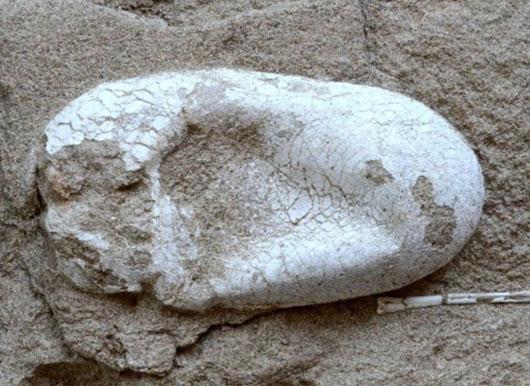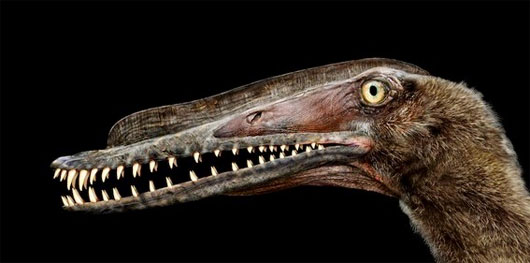Flying lizard eggs 120 million years in China
Five intact eggs and many adult flying lizard fossils were discovered in the Turpan-Hami basin, south of the Tianshan mountain range of Xinjiang autonomous region, northwest China.
The eggs are soft and flexible, have a hard outer shell, the inner layer is thick and soft, similar to the eggs of some snakes. Flying lizards may have buried eggs under sand to protect them from drying out.

An intact egg was unearthed in Xinjiang, China.(Photo: Live Science)
The fossils are defined as adult flying lizards, with differences in size, shape and condition of the crest. The team identified the eggs and fossils of the new flying lizard, whose scientific name is Hamipterus tianshanensis , thought to have died about 120 million years ago, during the Cretaceous period. Thousands of bones may still be being repelled in this area.
Live Science quoted Xiaolin Wang, a paleontologist at the Beijing Academy of Sciences, who said rare lizards of fossils were discovered. Previously, scientists only discovered 4 flying lizard eggs with flat forms.

Simulation image of a flying lizard Hamipterus tianshanensis.(Photo: Live Science)
Like birds and bats, flying lizards are also flying vertebrates, but different in wing parts. Their wings are composed of a skin membrane, muscle and other types of cells that extend from the legs to the fourth finger length.
The discovery of eggs near the bones of adult flying lizards suggests that there may be a shelter of this species near the excavation area. The finding also shows that flying lizards often live in large groups and prefer to live in the herd.
- Hundreds of 120 million year-old lizard eggs found in China
- Found fossil flying lizard eggs
- Detecting dinosaur fossils with eggs
- Discovered flying lizards that lived 125 million years ago in China
- What color does flying dinosaur eggs live 66 million years ago?
- Fossils of dinosaur eggs 70 million years in China
- Mexico: Lizard discovered 23 million years old
- China: Digging soil to build, discovered a series of dinosaur eggs of 145 million years
- China: Discovered 130 million year old dinosaur eggs still intact
- China: Going for a walk, stumbling across a 66 million year old dinosaur egg
- Detecting sea lizard fossils 75 million years
- Found fossil lizard 120 million years old
 Discovered an ancient centipede fossil 99 million years old
Discovered an ancient centipede fossil 99 million years old Discovered bat-like dinosaurs in China
Discovered bat-like dinosaurs in China Discovered a 200-year-old bronze cannon of the coast
Discovered a 200-year-old bronze cannon of the coast Discover 305 million-year-old spider fossils
Discover 305 million-year-old spider fossils